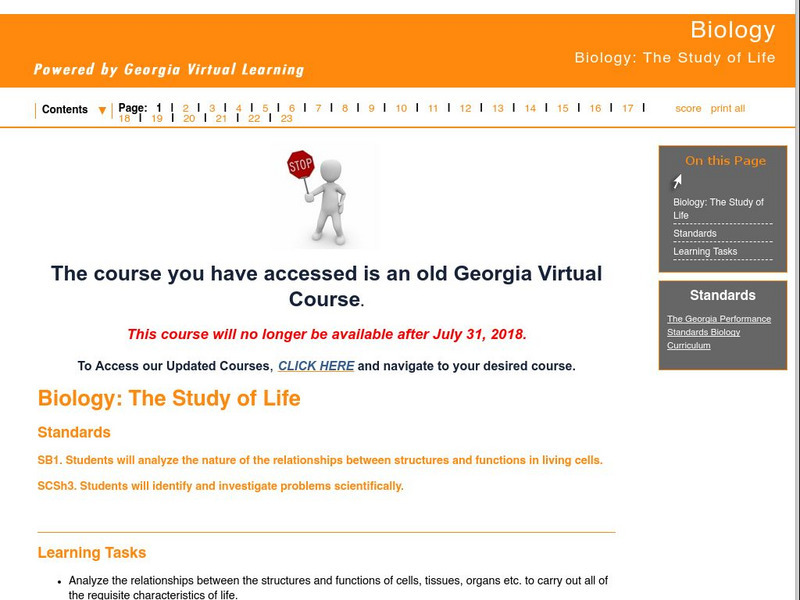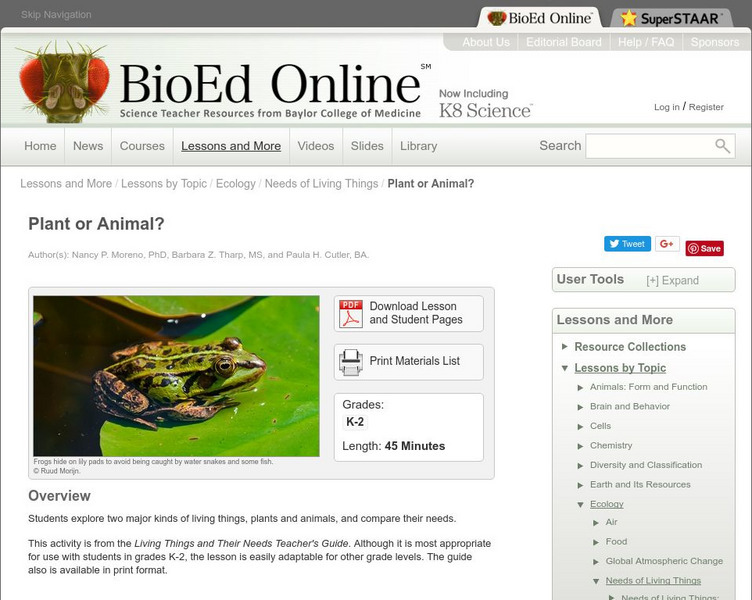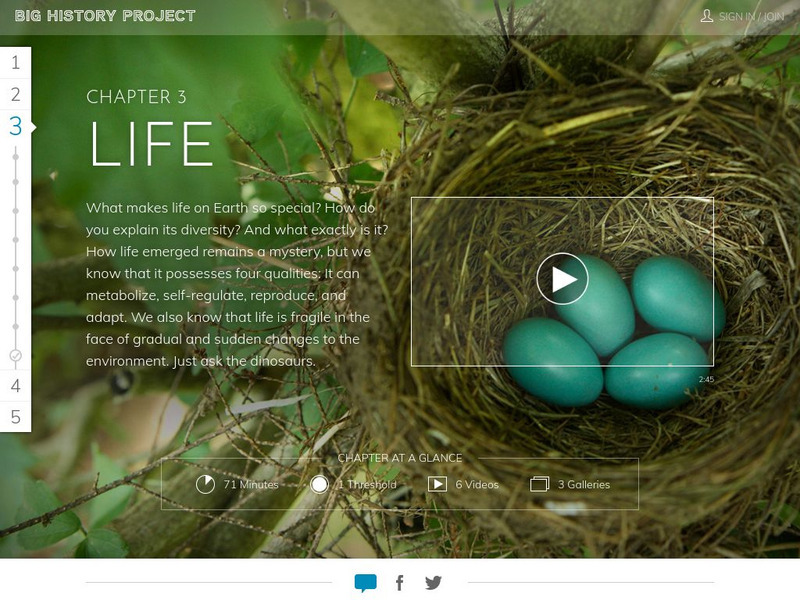K20 LEARN
It's Alive! Or, Is It?
Seems like a fairly simple question—until you begin asking your class! Get pupils acquainted with the characteristics of life through pairs classification, discussion, and scientific reading. The lesson plan, part of the K20 series, also...
American Museum of Natural History
Moving Mammals
How many different ways do mammals move from place to place? An online resource uses animation to show how different mammals move. Learners use a slider to speed up or slow down a variety of mammals. The versatile lesson works as a...
National Wildlife Federation
Night Friends - American Bats
Bats are a misunderstood species. Pupils learn about the characteristics of bats in a three-part lesson. They begin by examining the adaptations of different types of bats, then explore the misconceptions humans have about the species....
Biology Junction
Characteristics of Life
Life exists in many different forms from tiny nanobes to the Humongous Fungus, the largest form of life. Scholars learn the definition of life and the shared characteristics of these greatly varied organisms. They demonstrate knowledge...
University of Minnesota
C. elegans and the Search for Extraterrestrial Life
Introduce the topic of astrobiology in a unit that's out of this world. Biology scholars examine the search for extraterrestrial life by culturing roundworms, a species that has been key in helping researchers understand the...
American Physiological Society
What Environmental Conditions Lead to the Hatching of Brine Shrimp?
Will changing the environment in which brine shrimp live impact their reproductive success? Young scientists get hands-on experience studying the habitat of brine shrimp in a two-week immersion lesson. The teacher's guide provides all of...
New South Wales Department of Education
Is it Alive?
Interestingly enough, movement is not a characteristic of living things. The first activity in a series of 20 introduces learners to the concepts of living versus non-living things and then focuses on biologists and what they study....
Lerner Publishing
Living or Nonliving
It's alive! Or is it? Through a series of shared readings, whole class activities, and independent exercises children explore the difference between living and non-living things, creating a pair of printable books...
Kindergarten Kindergarten
Living and Non-Living Sort
What do an ice cream cone, bicycle, and alarm clock all have in common? That's exactly what young scientists will find out as sort these pictures and learn about the differences between living and non-living things.
Georgia Department of Education
Ga Virtual Learning: Biology: The Study of Life
A learning module where students analyze the relationships between the structures and functions of cells, tissues, organs to carry out all of the requisite characteristics of life. They also describe the scope of biological study and...
PBS
Pbs Learning Media: Living and Nonliving
What is it that distinguishes a living organism from a nonliving object? This collection of images presents examples that aren't as clear-cut as one might think, enticing students to question the meaning of life.
University of Oxford (UK)
Oxford University Museum of Natural History: Seven Life Processes
Explore the seven life processes that describe whether an animal is alive or not. Each characteristic is defined with examples and pictures. Also included is a living animal quiz to test how much you have learned.
BioEd Online
Bio Ed Online: Needs of Living Things: Pre Assessment
This is a pre-assessment to be done at the beginning of a unit on the needs of living things. Students draw themselves and what they need to survive. The lesson can be downloaded in PDF format.
BioEd Online
Bio Ed Online: Living Things and Their Needs: Plant or Animal?
In this lesson, learners investigate and compare the needs of plants and animals. The lesson can be downloaded in PDF format.
BioEd Online
Bio Ed Online: Living Things and Their Needs: Animals' Needs
Students learn about the basic needs of animals by creating and observing a worm terrarium. The lesson and student worksheets can be downloaded in PDF format.
BioEd Online
Bio Ed Online: Needs of Living Things: Post Assessment
A post-assessment at the end of a unit on the needs of living things. The lesson materials can be downloaded in PDF format.
American Association for the Advancement of Science
Aaas: Project 2061: Topic: Matter and Energy in Living Systems
[Free Registration/Login Required] Create a science test that checks for student understanding in science, for common misconceptions, as well as for correct ideas. This is a list of key ideas related to Matter and Energy in Living...
Other
Science4 Us: Living/nonliving
Students explore the similarities and differences between living and nonliving things and learn four characteristics that all living things share (they have needs, they are made up of parts, they respond to change, they reproduce)....
Other
Nelson Science: Healthy Ecosystems: The Needs of Living Things [Pdf]
A 4-page section of the Grade 7 Nelson Science and Technology Perspectives textbook. It looks at what organisms need to survive, specifically sunlight, air, water, and food. This is a visually-rich text with tips to help students'...
Channel 4 Learning
4 L: Science Essentials: Choose Life
A great review for understanding life cycles and many aspects of living things. Find topics and their main ideas, vocabulary review, quizzes, and complementary activities for teachers to use.
Exploratorium
Exploratorium: Microscope Imaging Station: Classroom Explorations
These microscope activities provide students with lots to explore. Activities include the characteristics of living things, math in science, cell biology, genetics, physiology, and mitosis.
Other
Big History Project: Chapter 3: Life
Learning module from the Big History Project on the topic of Life. Interactive site with video, text and photos to illustrate the concepts of diversity, what scientists know and what still remains a mystery.
CK-12 Foundation
Ck 12: Characteristics of Life
[Free Registration/Login may be required to access all resource tools.] Videos, texts, activities, and assessments about the factors that characterize living things.
Khan Academy
Khan Academy: Biology: Intro to Biology: What Is Life?
This article explores exactly what is considered alive but reviewing over the characteristics of life.






















